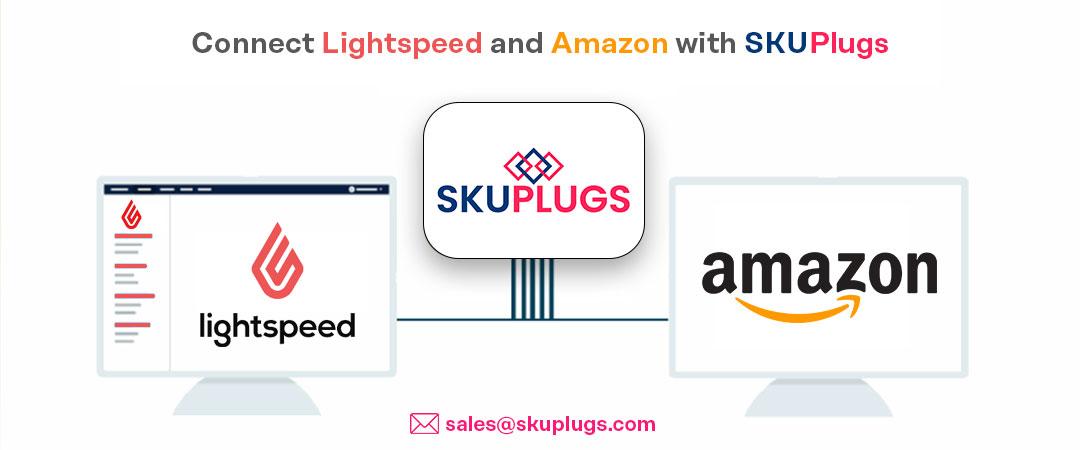In the fast-paced world of e-commerce, the ability to streamline operations and enhance efficiency is paramount for success. For businesses utilizing Lightspeed Retail and selling on Amazon, integrating these platforms can be a game-changer. In this comprehensive guide, we will explore the process of integrating Amazon Seller Central with Lightspeed Retail using SKUPlugs, focusing on the key benefits and steps to achieve a seamless Lightspeed Amazon integration.
Know about Lightspeed and Amazon
Lightspeed Retail POS is a cutting-edge point-of-sale system designed for modern retailers, offering a comprehensive solution for managing sales, inventory, and customer interactions. With its user-friendly interface and robust features, Lightspeed Retail empowers businesses to streamline operations, enhance customer experiences, and gain valuable insights to drive informed decision-making. Whether in-store or online, Lightspeed Retail POS is a versatile tool that adapts to the unique needs of diverse retail environments.
The Amazon marketplace is a global e-commerce platform that connects millions of buyers and sellers, offering a vast array of products and services. With its unparalleled reach and customer base, Amazon provides businesses with a unique opportunity to expand their market presence and increase sales. Sellers benefit from the platform’s logistics infrastructure, customer trust, and robust marketing tools, making it a pivotal hub for online commerce.
Understanding the Need for Integration:
As an e-commerce retailer, managing inventory, orders, and product listings across multiple platforms can be a daunting task. Lightspeed Retail is a powerful point-of-sale (POS) and inventory management system that helps businesses organize and streamline their operations. Amazon Seller Central, on the other hand, is a popular platform for online selling. Integrating these two platforms can significantly improve workflow efficiency, reduce manual errors, and provide real-time insights into your business performance.

Key Benefits of Lightspeed Amazon Integration with SKUPlugs:
1. Inventory Synchronization:
- Ensure accurate stock levels across Lightspeed Retail and Amazon Seller Central. Prevent overselling or stock-outs by automatically updating inventory in real-time.
2. Order Management:
- Seamlessly process and fulfill orders from both platforms within Lightspeed Retail. Eliminate the need for manual order entry and reduce the risk of order discrepancies.
3. Product Listing Updates:
- Effortlessly manage product listings on Amazon directly from Lightspeed Retail. Update product details, pricing, and availability without navigating between platforms.
4. Centralized Reporting:
- Gain comprehensive insights into your business performance with centralized reporting. Analyze sales, inventory, and customer data from both Lightspeed Retail and Amazon in one place.
5. Time and Cost Savings:
- Minimize manual data entry and administrative tasks, allowing your team to focus on strategic activities.Reduce the likelihood of errors associated with manual processes.
Steps to Integrate Amazon Seller Central with Lightspeed Retail using SKUPlugs:
1. Sign Up and Install SKUPlugs
- Visit the SKUPlugs website and sign up for an account.
- Connect Lightspeed Retail POS system from the integration platform.
- In a few clicks you can easily connect your Lightspeed Retail POS
2. Configure Lightspeed Retail:
- After Connecting your Lightspeed Retail account to SKUPlugs, you need to configure it as per your business requirement.
- Set up synchronization preferences for inventory, orders, and product listings.
3. Connect Amazon Seller Central:
- Link your Amazon Seller Central account to SKUPlugs.
- Authorize SKUPlugs to access your Amazon store data.
4. Configure Integration Settings:
- Customize integration settings based on your business requirements.
- Map Lightspeed Retail and Amazon attributes to ensure accurate data transfer for stock and price sync.
5. Test and Validate:
- Conduct a test synchronization to ensure data accuracy. You can test the sync with few selected items.
- Validate inventory updates, order processing, and product listing changes.
6. Launch the Integration:
- Once testing is successful, launch the integration and start your sync for all the catalog.
- Our technical team will review your integration for first few days
Lightspeed Amazon integration with SKUPlugs is a strategic move for e-commerce businesses looking to enhance operational efficiency and drive growth. By synchronizing inventory, orders, and product listings seamlessly, businesses can save time, reduce errors, and gain valuable insights into their multichannel operations. Follow the steps outlined in this guide to embark on a journey towards a more streamlined and successful e-commerce business.
Original Source: Lightspeed and Amazon integration
